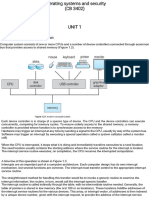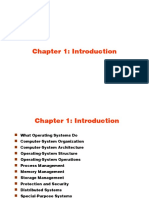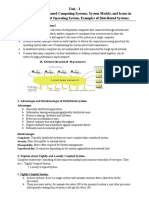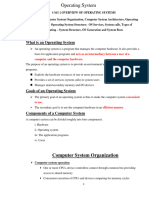REBYO
REBYO
Uploaded by
Kacie OrtizCopyright:
Available Formats
REBYO
REBYO
Uploaded by
Kacie OrtizCopyright
Available Formats
Share this document
Did you find this document useful?
Is this content inappropriate?
Copyright:
Available Formats
REBYO
REBYO
Uploaded by
Kacie OrtizCopyright:
Available Formats
OSC REVIEWER high-availability service - service that will continue even if
one or more systems in the cluster fail.
Chapter 1 graceful degradation - the ability to continue providing
service proportional to the level of surviving hardware
Operating System - is software that manages a computer’s fault tolerant - systems go beyond graceful degradation and
hardware. are called
Hardware - provides the basic computing resources for the asymmetric clustering - one machine is in hot-standby mode
system. while the other is running the applications.
Application Programs - define the ways in which these hot-standby - host machine does nothing but monitor the
resources are used to solve users computing problems. active server.
Resource Utilization - how various hardware and software symmetric clustering - two or more hosts are running
resources are shared. applications and are monitoring each other.
Touch Screen - where the user interacts with the system by Parallelization - divides a program into separate components
pressing and swiping fingers across the screen. that run in parallel on individual cores in a computer or
Control Program - manages the execution of user programs computers in a cluster.
to prevent errors and improper use of the computer. Trap - another form of interrupt
Middleware - a set of software frameworks that provide system call - specific request from a user program that an
additional services to application developers. operating-system service be performed by executing a special
Bus - provides access between components and shared operation
memory Multiprogramming - increases CPU utilization
Device driver - understands the device controller and Multitasking - is a logical extension of multiprogramming
provides the rest of the operating system with a uniform virtual memory - a technique that allows the execution of a
interface to the device. process that is not completely in memory
2 Interrupt Request Line Modes of Operation
Nonmaskable interrupt - which is reserved for events such as Kernel Mode
unrecoverable memory errors. User Mode
Maskable - it can be turned off by the CPU before the
execution of critical instruction sequences that must not be operating system is a resource manager.
interrupted. Protection - any mechanism for controlling the access of
processes or users to the resources defined by a computer
Interrupt Chaining - in which each element in the interrupt system.
vector points to the head of a list of interrupt handlers. security - defend a system from external and internal attacks.
Main memory - also called random-access memory, or RAM. Virtualization - is a technology that allows us to abstract the
Volatile - loses its content when power is turned off or hardware of a single computer
otherwise lost. A user of a virtual machine can switch among the various
Firmwar - storage that is infrequently written to and is operating systems
nonvolatile. Emulation - involves simulating computer hardware in
Secondary storage - extension of main memory software
Tertiary storage - to store backup copies of material stored Network - a communication path between two or more
on other devices. systems.
Semiconductor memory - consists of semiconductor-based TCP/IP - is the most common network protocol, and it
electronic circuits provides the fundamental architecture of the Internet.
2 Types of Nonvolatile Storage Characteristics of a Network
Mechanical local-area network (LAN) - connects computers within a
Electrical room, a building, or a campus.
wide-area network (WAN)- usually links buildings, cities, or
Core - is the component that executes instructions and countries.
registers for storing data locally. metropolitan-area network (MAN) - could link buildings
Multiprocessor systems - have two (or more) processors, within a city.
each with a single-core CPU. personal-area network (PAN) - between a phone and a
symmetric multiprocessing (SMP) - each peer CPU processor headset or a smartphone and a desktop computer
performs all tasks.
multicore systems - multiple computing cores reside on a network operating system - is an operating system that
single chip provides features such as file sharing across the network
Processor - A physical chip that contains one or more CPUs. array - is a simple data structure in which each element can
shared system interconnect - all CPUs share one physical be accessed directly
address space
blade servers - are systems in which multiple processor List - represents a collection of data values as a sequence.
boards, I/O boards, and networking boards are placed in the linked list - items are linked to one another.
same chassis.
clustered system - gathers together multiple CPUs.
Types of Linked List Infrastructure as a service (IaaS)—servers or storage available
singly linked list - each item points to its successor over the Internet
doubly linked list - a given item can refer either to its
predecessor or to its successor realtime operating system - used when rigid time
circularly linked list - the last element in the list refers to the requirements have been placed on the operation of a
first element, rather than to null processor or the flow of data
Version control systems - allow a user to “pull” an entire
Stack - is a sequentially ordered data structure that uses the source code tree to his computer and “push” any changes
last in, first out (LIFO) principle back into the repository for others to then pull
Queue - is a sequentially ordered data structure that uses the
first in, first out (FIFO) principle Interrupts - are a key way in which hardware interacts with
tree data structure - a data structure that can be used to the operating system. A hardware device triggers an interrupt
represent data hierarchically by sending a signal to the CPU to alert the CPU that some
general tree - a parent may have an unlimited number of event requires attention. The interrupt is managed by the
children. interrupt handler
binary tree - a parent may have at most two children, which process - is the fundamental unit of work in an operating
we term the left child and the right child. system.
binary search - tree additionally requires an ordering 4 - is licensed to allow no-cost use, redistribution, and
between the parent’s two children modification
hash function - takes data as its input, performs a numeric
operation on the data, and returns a numeric value
hash map, which associates (or maps) [key:value] pairs using
a hash function.
Bitmap - is a string of n binary digits that can be used to
represent the status
disk blocks - medium-sized disk drive might be divided into
several thousand individual units
Portals - which provide web accessibility to their internal
servers
firewall - protect their networks from security breaches.
server systems - satisfy requests generated by client systems
Server Systems
compute-server system - provides an interface to which a
client can send a request to perform an action
The file-serve system - provides a file-system interface where
clients can create, update, read, and delete files
Types of Computing
Mobile computing - refers to computing on handheld
smartphones and tablet computer
Client - Server Computing - Contemporary network
architecture features arrangements in which server systems
satisfy requests generated by client systems.
Peer - to - Peer Computing - clients and servers are not
distinguished from one another.
Cloud computing - is a type of computing that delivers
computing, storage, and even applications as a service across
a network.
Types of Cloud Computing
Public cloud - a cloud available via the Internet to anyone
willing to pay for the services
Private cloud - a cloud run by a company for that company’s
own use
Hybrid cloud - a cloud that includes both public and private
cloud components
Software as a service (SaaS) - one or more applications (such
as word processors or spreadsheets) available via the
Internet
Platform as a service (PaaS)—a software stack ready for
application use via the Internet (for example, a database
server)
You might also like
- Sap Fico Configuration GuideDocument9 pagesSap Fico Configuration GuidePrathamesh ParkerNo ratings yet
- Hospital Management System Use Case DiagramDocument4 pagesHospital Management System Use Case DiagramLemu Morka50% (2)
- KASO VISION Solution Taekwondo Kyorugi Scoring SoftwareDocument22 pagesKASO VISION Solution Taekwondo Kyorugi Scoring SoftwarePhallyNo ratings yet
- KIMMMMMDocument2 pagesKIMMMMMKacie OrtizNo ratings yet
- CH 1Document10 pagesCH 1Diamond MindglanceNo ratings yet
- Operating Systems Notes From Gitam WebsiteDocument63 pagesOperating Systems Notes From Gitam Websitesidhartha1991No ratings yet
- Linux Driver 1Document15 pagesLinux Driver 1lakshmi1989No ratings yet
- III BCA B OS Unit IDocument12 pagesIII BCA B OS Unit ITesting Fun100% (1)
- Perating YstemsDocument77 pagesPerating YstemsParthiban SoundarrajanNo ratings yet
- Cs OSS 1Document39 pagesCs OSS 1cjjasmin3No ratings yet
- ch01 Introduction MDocument49 pagesch01 Introduction MSanjeev RNo ratings yet
- Q1. A) What Are The Two Criteria For Classification of The Advanced Operating Systems? Discuss Any Two Operating Systems in Both The CategoriesDocument27 pagesQ1. A) What Are The Two Criteria For Classification of The Advanced Operating Systems? Discuss Any Two Operating Systems in Both The Categoriesdevil angelNo ratings yet
- Ch1 AnnotatedDocument27 pagesCh1 AnnotatedMeetendra SinghNo ratings yet
- Chp1 IntroductiontoOSDocument60 pagesChp1 IntroductiontoOSsaloniNo ratings yet
- MSCIT 4th COMP2115 1,2,3Document23 pagesMSCIT 4th COMP2115 1,2,3countsohaib.asNo ratings yet
- OS ReviewerDocument4 pagesOS ReviewerNickNo ratings yet
- Operating System Unit 1 & 2 Intro NotesDocument48 pagesOperating System Unit 1 & 2 Intro NotesLaxmi Computer Science and EngineeringNo ratings yet
- Chapter 3: Operating-System StructuresDocument31 pagesChapter 3: Operating-System StructuresDiamond MindglanceNo ratings yet
- Unit-1 OS OverviewDocument36 pagesUnit-1 OS Overviewsanjana.devarapalli7No ratings yet
- Chapter 1&2Document28 pagesChapter 1&2Nguyễn Trọng QuốcNo ratings yet
- Module 1Document41 pagesModule 1japesh dixitNo ratings yet
- Neil Aldrin L. Abel Notes As Assignment Bs Cpe 3 - 3 10/19/2020Document4 pagesNeil Aldrin L. Abel Notes As Assignment Bs Cpe 3 - 3 10/19/2020Marc AndalloNo ratings yet
- OS NotesDocument16 pagesOS NotesRahul KumarNo ratings yet
- Unit I-Processes and Threads Operating System:: V+ TeamDocument35 pagesUnit I-Processes and Threads Operating System:: V+ TeamVarun ShankarNo ratings yet
- Lect1 - IntroductionDocument76 pagesLect1 - Introductionxiceca3316No ratings yet
- OS Assignment 1 Part 1,2Document9 pagesOS Assignment 1 Part 1,2humairanaz100% (2)
- Unit IDocument8 pagesUnit Ivenkata rama krishna rao junnuNo ratings yet
- This Ability To Continue Providing Service Proportional To The Level of Surviving Hardware Is Called Graceful DegradationDocument7 pagesThis Ability To Continue Providing Service Proportional To The Level of Surviving Hardware Is Called Graceful DegradationMeena NegiNo ratings yet
- Computer System ServicingDocument20 pagesComputer System ServicingjheraNo ratings yet
- CH 1Document22 pagesCH 1jeela1No ratings yet
- Introduction To Distributed Operating Systems Communication in Distributed SystemsDocument150 pagesIntroduction To Distributed Operating Systems Communication in Distributed SystemsSweta KamatNo ratings yet
- Chapter 1: Introduction: Operating System ConceptsDocument21 pagesChapter 1: Introduction: Operating System ConceptsGurvinder SinghNo ratings yet
- 1 A.Sathiyaraj/Assoc - Prof/CSE Dept/RISE GroupsDocument16 pages1 A.Sathiyaraj/Assoc - Prof/CSE Dept/RISE GroupsSai Pavitra VangalaNo ratings yet
- Midterm Review: CMSC 421 Fall 05Document75 pagesMidterm Review: CMSC 421 Fall 05asdNo ratings yet
- UNIT-1 Operating System - Concepts:: DefinitionDocument10 pagesUNIT-1 Operating System - Concepts:: DefinitionRajeswaranaidu DarsiNo ratings yet
- Linux 1 PDFDocument11 pagesLinux 1 PDFAmerulzai SyazaNo ratings yet
- Lecture 1 Thay TuDocument87 pagesLecture 1 Thay Tuapi-3801193100% (1)
- ICTnotesDocument4 pagesICTnotesNominee OnlineNo ratings yet
- Advance Computer Architecture2Document36 pagesAdvance Computer Architecture2AnujNo ratings yet
- InroductionDocument25 pagesInroductionAditya RathodNo ratings yet
- UNIT-I, II, III From KhitDocument94 pagesUNIT-I, II, III From KhitMalliNo ratings yet
- Operating System ServiceDocument6 pagesOperating System ServiceJONAS J JONASNo ratings yet
- Inroductiion To OSDocument78 pagesInroductiion To OSthilipkumar.p1985No ratings yet
- MIT-101-Acitvity 1-Operating System and NetworkingDocument5 pagesMIT-101-Acitvity 1-Operating System and NetworkingCarlo Moon CorpuzNo ratings yet
- CS02DOS Unit 1UNit - 1 IntroductionDocument6 pagesCS02DOS Unit 1UNit - 1 IntroductionSalar AhmedNo ratings yet
- Os Unit 1 & 2.Document22 pagesOs Unit 1 & 2.AKG YOUTUBENo ratings yet
- Operating Systems All NotesDocument53 pagesOperating Systems All NotesCJ Weche (C.O.G)No ratings yet
- Introduction To Basic OS ConceptsDocument39 pagesIntroduction To Basic OS ConceptsYogi SahuNo ratings yet
- Operating System NotesDocument118 pagesOperating System Notesjitendrabudholiya620No ratings yet
- Os 4 Units - RotatedDocument90 pagesOs 4 Units - Rotatednarsi reddy MorthalaNo ratings yet
- Unit 1 - Operating System - WWW - Rgpvnotes.inDocument15 pagesUnit 1 - Operating System - WWW - Rgpvnotes.inSHIVAM KUMARNo ratings yet
- Network and Distributed OSDocument5 pagesNetwork and Distributed OSSarfaraz EdrishNo ratings yet
- Unit1 Operating SystemDocument25 pagesUnit1 Operating SystemPoornima.BNo ratings yet
- Operating System StructureDocument23 pagesOperating System StructureAdi NurNo ratings yet
- Unit-2 OsDocument18 pagesUnit-2 OsAtharva ShasaneNo ratings yet
- Jimma University: Jimma Institute of Technology Faculty of ComputingDocument7 pagesJimma University: Jimma Institute of Technology Faculty of ComputingadmachewNo ratings yet
- Components of The Computerized System: I. HardwareDocument6 pagesComponents of The Computerized System: I. HardwareAnonymous t8Nwi0WNo ratings yet
- Chapter 01 Introduction To Operating SystemsDocument52 pagesChapter 01 Introduction To Operating SystemsMickNo ratings yet
- Module I - OSDocument41 pagesModule I - OSPrakash HegdeNo ratings yet
- An Operating SystemDocument97 pagesAn Operating SystemBaptist GHNo ratings yet
- Cpe 330 Week 1 Lecture 1Document16 pagesCpe 330 Week 1 Lecture 1Rafael D. SanchezNo ratings yet
- Introduction &: Operating SystemsDocument36 pagesIntroduction &: Operating SystemsjunaidNo ratings yet
- Operating Systems: Concepts to Save Money, Time, and FrustrationFrom EverandOperating Systems: Concepts to Save Money, Time, and FrustrationNo ratings yet
- Forms of CommunicationDocument2 pagesForms of CommunicationKacie OrtizNo ratings yet
- RivaDocument3 pagesRivaKacie OrtizNo ratings yet
- UntitledDocument3 pagesUntitledKacie OrtizNo ratings yet
- MMS ReviewerDocument3 pagesMMS ReviewerKacie OrtizNo ratings yet
- Eme C#Document3 pagesEme C#Kacie OrtizNo ratings yet
- ReportDocument4 pagesReportKacie OrtizNo ratings yet
- Provide Emergency AidDocument2 pagesProvide Emergency AidKacie OrtizNo ratings yet
- Teac Ad-600 PDFDocument50 pagesTeac Ad-600 PDFAnonymous Pr8IgKeNo ratings yet
- Renovating The Scott 222C, Part 3Document13 pagesRenovating The Scott 222C, Part 3abbi johnsonNo ratings yet
- Final Review RoselineDocument29 pagesFinal Review RoselineAnonymous 0MQ3zRNo ratings yet
- GAD Microproject FormatDocument18 pagesGAD Microproject FormatDevendra MaliNo ratings yet
- Lc32le240-340m EN SVC PDFDocument70 pagesLc32le240-340m EN SVC PDFKenneth S.No ratings yet
- Marketing Bet-Emec Ver - 2023Document33 pagesMarketing Bet-Emec Ver - 2023magma72No ratings yet
- Fuses: A Short Report On FusesDocument6 pagesFuses: A Short Report On FusesSachin KumarNo ratings yet
- Electrical Fire Safety PresentationDocument16 pagesElectrical Fire Safety PresentationSuresh Vedala0% (1)
- SAP MM - Master DataDocument9 pagesSAP MM - Master DataSAP E-learnNo ratings yet
- Fundamentals of Networking: Module Page 1/7 Document Page 1Document7 pagesFundamentals of Networking: Module Page 1/7 Document Page 1Cikgu Azry Azeem PetronessaNo ratings yet
- H.kaadan - Resume'Document4 pagesH.kaadan - Resume'Hadi KaadanNo ratings yet
- Samil Power Specification PDFDocument8 pagesSamil Power Specification PDFduckman2009No ratings yet
- Aruba VHD VRD Theory GuideDocument62 pagesAruba VHD VRD Theory Guideframe28No ratings yet
- PigDocument24 pagesPigdeepansh chanduNo ratings yet
- ACKNOWLEDGEMENTDocument4 pagesACKNOWLEDGEMENTSowmya KamatamNo ratings yet
- 1.Hvdc Basic TheoryDocument41 pages1.Hvdc Basic TheoryJakka VenkatNo ratings yet
- PF User GuideDocument62 pagesPF User Guidesrinivas3usNo ratings yet
- Whatsapp Chat Analyzer IJERTV9IS050676Document4 pagesWhatsapp Chat Analyzer IJERTV9IS050676vardhan reddyNo ratings yet
- HPCL ErpDocument9 pagesHPCL ErpSurya Teja100% (1)
- Spring 2020 ISOM3730 Quiz Solution: Depth Analysis To Score Full CreditDocument5 pagesSpring 2020 ISOM3730 Quiz Solution: Depth Analysis To Score Full CreditSin TungNo ratings yet
- Participant Guide: Foxboro Control Systems - Configuartion Essentials Course No. 5001Document16 pagesParticipant Guide: Foxboro Control Systems - Configuartion Essentials Course No. 5001DWVIZCARRA100% (1)
- Sample Questions (Objective) A. Fill in The BlanksDocument16 pagesSample Questions (Objective) A. Fill in The BlanksDikesh ShresthaNo ratings yet
- PSPPM Fact SheetDocument2 pagesPSPPM Fact SheetTusharNo ratings yet
- CS8581 - Computer Networks Lab (PTR@9119) ManualDocument68 pagesCS8581 - Computer Networks Lab (PTR@9119) ManualBharath kumarNo ratings yet
- Hash Humanoid Robot V3Document25 pagesHash Humanoid Robot V3mito urbanoNo ratings yet
- Ace of Pace Ranklist Adv DT 1-04-2018Document7 pagesAce of Pace Ranklist Adv DT 1-04-2018Suryaprakash GuptaNo ratings yet
- Itp ErectionDocument6 pagesItp ErectionvigneshNo ratings yet
































































































